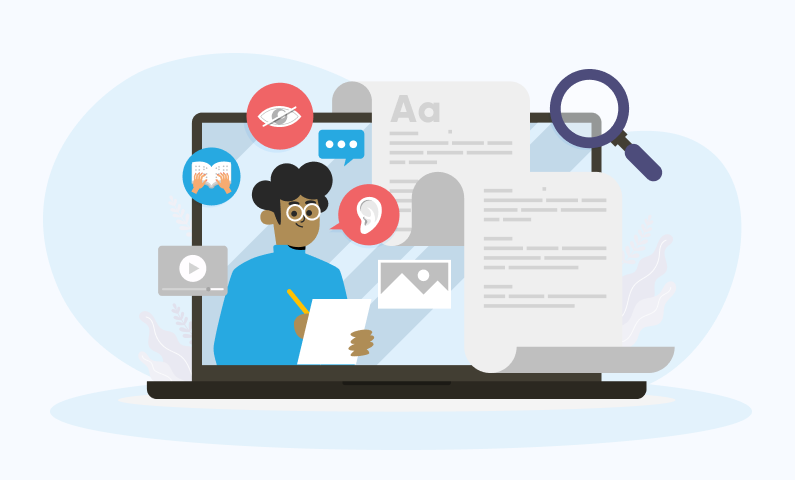The journey of equality and accessibility for people with disabilities in the USA has been long and demanding. However, the Americans with Disabilities Act of 1990 has prevented discrimination to date.
Over time, there have been many versions of this act. As a result of digitization, we can see the inclusion of WCAG in the Americans with Disabilities Act. It is the benchmark for website accessibility.
But what exactly comes under ADA compliance and WCAG compliance? Let’s begin with the terms for a better understanding.
What is ADA Compliance?

The Americans with Disabilities Act or ADA is often connected with the physical accommodations that businesses should make for people with disabilities. These facilities normally incorporate, for instance, wheelchair availability and the utilization of Braille for clients who are visually impaired. Be that as it may, the ADA also stretches out to the advanced domain.
ADA requires a strict following of the accessibility rules without any specific directions or guidelines. Hence, WCAG. Moreover, since there is a surge in digital content WCAG is what we should look into.
WCAG Compliance
The Web Content Accessibility Guidelines or WCAG, created by the Web Accessibility Initiative (WAI) is an ISO standard. These guidelines are the most acknowledged way to be utilized by engineers and organizations.
However, it is constantly updated to meet all accessibility needs. The latest version of this is WCAG 2.2 which later has expanded to WCAG 3.0, having additions in the rules.
These guidelines started with the WCAG 2.0 version that included 4 main principles and 12 criteria. This was a broad and nitty-gritty record that contained countless principles, rules, clarifications, and guidelines for these clarifications. Further, version 2.1 extended with 17 criteria that focused mainly on tablet and mobile interactions. It showed proper guidelines but not for all users with disabilities. Its focus was on making websites accessible for people with low vision and cognitive incapacities.
The introduction of version 2.2 fulfilled the new digital requirement quite impressively. It states that in the case of Captcha, there needs to be an alternative path to authenticate that should not need some cognitive tests.
Version 3.0 focuses on the web content and its operation on a much wider canvas. It is more approachable, operable, and vigorous with regard to disabilities.
Why do ADA compliance and WCAG compliance matter?

Why should I make my website accessible? What is in it for my business? These are the questions that might come up in your mind without a clear answer. So let’s simplify them. Here are the benefits of being ADA and WCAG Compliant:
- Provide equal opportunities to everyone
- Increase your audience reach with the disabled community
- Better user experience for all
- Better SEO support
- Ensuring compliance with the federal law
- Low website bounce rate, average visit duration increases
In case you don’t care to make your website ADA compliant, there is a hefty fine of $55,000 to $75,000 for first-time violations and a $150,000 fine for every repeat violation.
ADA compliance and WCAG compliance compliance: How can we help you?
Since ADA compliance is one of the USA’s most extensive bits of regulations, it incorporates everything from prerequisites for organizations and not-for-profit associations as well. We at Ajackus aim to maintain and promote the Americans with Disabilities Act.
Working on the POUR principle of these guidelines – Perceivable, Operable, Understandable, and Robust – we give your organizations:
1. Accessibility testing and monitoring
Considering the main motive behind ADA compliance and WCAG compliance to make your website accessible for all audiences, Ajackus gives your website:
- Keyboard accessibility
- Accessibility through speech and visual support tools
- Alternative text to images
- Structuring your web pages using CSS layout and styles
- Accessibility at varied Zoom levels
These points are just a glimpse of what we can offer you. However, with the newer version coming along every few years, monitoring and maintenance of the websites is crucial. It is advisable to have period checks every 6 months. It ensures that your website grows as web pages get added.
With this, there is a high opportunity that accessibility issues will emerge. Having a complete understanding of the importance of monitoring, we at Ajackus plan and execute standard site checks and assessments for your websites.
2. Digital accessibility and monitoring
Mobile/Web applications may be coded to make everything accessible with just a tap but for people with disabilities, not so much. Here is where we step in. While making your websites with ADA compliance and WCAG compliance, we make sure about the seamless user experience in order to make them more fit for use.
We provide you with insights using various tools like Accessibility Insight, ANDI, Text Spacing Bookmarklet, Heading Bookmarklet, Landmark Bookmarklet, and many more.
3. Disability inclusion
It is characterized as having individuals with disabilities taking active participation in everyday activities similar to their non-disabled peers. It is a fact that 26% of the USA’s adult citizens are disabled. If your business doesn’t have a strategy for those, then you are missing out on your potential audience. Disability inclusion is basically utilizing this untapped market for your business.
How do I get the compliance certification?

There is no such association, organization, or any kind of entity that certifies, regardless of whether the organization is WCAG compliant. This certification is, to a greater extent, a reference guide that helps your company achieve reasonable accessibility.
However, there are three ways to attain it.
1. Statement of accessibility:
This method oversees a particular set of people with disabilities. The company needs to ensure that the business attends to that particular category of disability and that it also satisfies the WCAG guidelines concerning that disability.
2. Voluntary Product Accessibility Template (VPAT) Statement:
Here, the company needs to follow no set guidelines or rules. Instead, it is a template that suggests the reasonable accessibility of websites and applications. Moreover, this method of certification is the best possible attempt at compliance.
3. WCAG conformance claim:
In the conformance claim, version 2.0 of the WCAG guidelines is more stable than the earlier versions; hence, WCAG 2.0 conformation is the preferred way of getting the certification. This method has 3 levels of conformance as a three-tiered grading system:
- Level A: Minimal compliance of accessibility
- Level AA: Acceptable compliance, that is, the conformance cited in pieces of legislation or in legal settlements
- Level AAA: Maximum compliance
Why Website Accessibility Really Matters?

Alright, let’s break this down in a more specific way.
Legality
So, legally speaking, most websites have to play by the rules set out in either the ADA compliance or Section 508 of the Rehabilitation Act. And you know what? It’s not just the good guys advocating for web accessibility – there’s also a bunch of folks and lawyers looking for quick wins.
DEI
Now, when we talk about Diversity, Equity, and Inclusion (DEI), it’s not just about physical spaces. We’re talking digital, too, making sure everyone, including those with disabilities, can smoothly cruise through the online world. The pandemic definitely shoved the spotlight on how important digital access is, especially when the whole world practically lived online.
And check this out – it’s not only the 61 million people with disabilities in the US who need a little extra consideration. Consider the 71 million Boomers who collectively have $548 billion in disposable income. They encounter shared experiences related to vision, hearing, cognitive functions, and fine motor skills.
2024 Update
Now, in the 2024 landscape, conversational AI like Bing and ChatGPT are throwing in some twists to the website accessibility game. Despite being super smart, these AI models hit roadblocks just like assistive technologies do.
So, sticking to the Web Content Accessibility Guidelines (WCAG) isn’t just a rulebook thing; it’s a smart move to make sure even Artificial Intelligence Operatives (AIO) can smoothly navigate.
Evaluating Current Website Compliance Standards in 2024
As we navigate through 2024, the significance of aligning websites with ADA compliance standards and adhering to Web Content Accessibility Guidelines (WCAG) has never been more crucial. Surprisingly, however, a significant majority of websites still fall short of meeting these standards.
The undeniable truth remains: unless a website is purposefully designed and constructed with a focus on web accessibility and ADA compliance, it typically falls below these essential benchmarks. Overlooking these ADA requirements not only exposes your website to potential lawsuits but also poses risks to your brand reputation and missed business opportunities.
Despite the explicit requirements for ADA compliance, the prevailing reality indicates that a substantial number of websites continue to be non-compliant. Data from the Web AIM Million Project at Utah State University in 2023 uncovered a concerning trend: a staggering 96.3% of the top million homepages did not meet ADA standards, each presenting an average of 50.0 barriers to accessibility.
This statistic is not merely a numerical figure; it underscores the pervasive and profound issue of non-compliance in the web landscape, underscoring both the breadth and depth of the problem. Addressing these concerns is imperative for organizations committed to upholding the highest standards of accessibility and inclusivity in the digital realm.
Making Your Website Follow ADA Compliance: A Two-Step Guide

So, you’ve decided it’s time to make your website follow ADA compliance, but where do you start? Well, it’s a two-step process, and we’re here to guide you through it.
Step One: Conduct a WCAG Audit
1. Understanding the Nuances:
Keep in mind that automated audits alone won’t cut it. The Web Content Accessibility Guidelines (WCAG) are nuanced and open to interpretation. Automated tools only catch about 30% of the issues, so human testing is essential.
2. Types of Testing:
- Automated WCAG Testing: A thorough crawl to identify basic compliance issues.
- Manual WCAG Testing: A deeper analysis through human review of code and unique page use cases.
- Assistive Technology Testing: Using tools like screen readers to assess real-world accessibility.
3. Qualities of Effective Testers:
Look for an accessibility expert with broad experience, and an understanding of use cases, assistive technologies, website code, WCAG, and legal implications.
Pro Tip: Request a comprehensive WCAG audit report that identifies issues and provides actionable solutions.
4. Involving People with Disabilities:
While debatable, what matters most is selecting an auditor with experience and technical expertise. Our team is ability-agnostic, ensuring thorough cross-ability testing.
5. Cost Considerations:
WCAG audit costs vary based on factors like website size and complexity. Balancing legal risks with accessibility commitment is key, and costs typically range from $3,000 to $30,000.
6. Cost Reduction Strategies:
Consider options like a “keypage” audit for budget-conscious approaches, ensuring human testing and steering clear of quick-fix AI solutions.
Step Two: Website Remediation
1. Implementing Solutions:
Armed with the audit report, your design, development, and content teams can break down tasks and implement recommended solutions.
2. Caution Against Quick Fixes:
Be wary of solutions like overlays, toolbars, or widgets promising quick ADA compliance. Authentic compliance requires a thoughtful, thorough approach.
3. Maintaining Compliance:
Compliance is an ongoing commitment. Regular audits, especially after updates, are crucial. Automated tools can check new elements, but manual testing is essential for significant changes.
Making your website follow ADA compliance is not a one-time task but an ongoing journey to ensure inclusivity and accessibility for all.
FAQs regarding ADA compliance and WCAG compliance
Q. Is there something that designers can do to make the websites and applications more color-compliant?
A. Certainly. Section 3 of the WCAG compliance talks about color contrast. The designers can include colors like Red, Blue, and Green, and their combinations while they create websites and applications. These colors are supposedly the best in order to highlight content.
Q. Are there similar compliance requirements in other geographical regions?
A. 26% of the population falls under the category of disabilities. In order to make the websites and applications more accessible to all, North America has pushed for ADA compliance and WCAG compliance regulations. However, Australia also has it as a legal act.
Q. Can we leverage the company experience to target those markets?
A. Absolutely. Making your website compliant is also more of an opportunity for every business to reach out to more customers.
Q. Is there any legal requirement to be WCAG compliant?
A. Yes, government offices and their contractors are expected to be compliant with the WCAG 2.0 version. However, for private organizations, the answer to this is more complicated. They are not legally required to follow a particular standard like WCAG; however, their websites and applications must be accessible under any conformation.
This will help them to avoid penalties. We have observed that private organizations like Netflix and Target have been sued in the past, which has cost them money and their reputations.
Q. What budget do we have to spend to complete the compliances?
A. The budget depends on the specific application and the utility that is targeted to be made compliant. The designing of an application from its initial stages might require less budget. On an existing application, it is volume-driven. It depends on the number of functionalities and APIs.
However, any budget spent on making the applications compliant will definitely be worth making sure the reputation remains intact.
Q. Is there any deadline for companies to be WCAG compliant?
The government has not yet issued any specific date to be the last to make the applications compliant. However, there is definitely an urgency for it to avoid hefty fines.
Conclusion: ADA compliance and WCAG compliance
Here at Ajackus, one of our most noteworthy missions is to develop society through accessible and comprehensive signage. We accept that this, likewise, incorporates education about ADA compliance and WCAG compliance.
It gives everyone the option to partake in everything. We believe in maintaining the vision of the ADA through robust, secure, and scalable business solutions.
While we cater to a wide range of clients and their requirements, we make sure that our work satisfies the ADA compliance and WCAG compliance guidelines.
Need help with ADA compliance? Connect with us here.
Let us take a step together on your accessibility journey.


